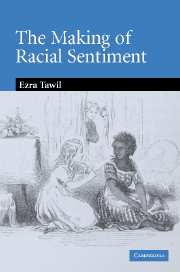Book contents
- Frontmatter
- Contents
- Acknowledgments
- Introduction: Toward a literary history of racial sentiment
- 1 The politics of slavery and the discourse of race, 1787–1840
- 2 Remaking natural rights: race and slavery in James Fenimore Cooper's early writings
- 3 Domestic frontier romance, or, how the sentimental heroine became white
- 4 “Homely legends”: the uses of sentiment in Cooper's The Wept of Wish-Ton-Wish
- 5 Stowe's vanishing Americans: “negro” interiority, captivity, and homecoming in Uncle Tom's Cabin
- Conclusion: Captain Babo's cabin: racial sentiment and the politics of misreading in Benito Cereno
- Notes
- Index
5 - Stowe's vanishing Americans: “negro” interiority, captivity, and homecoming in Uncle Tom's Cabin
Published online by Cambridge University Press: 22 September 2009
- Frontmatter
- Contents
- Acknowledgments
- Introduction: Toward a literary history of racial sentiment
- 1 The politics of slavery and the discourse of race, 1787–1840
- 2 Remaking natural rights: race and slavery in James Fenimore Cooper's early writings
- 3 Domestic frontier romance, or, how the sentimental heroine became white
- 4 “Homely legends”: the uses of sentiment in Cooper's The Wept of Wish-Ton-Wish
- 5 Stowe's vanishing Americans: “negro” interiority, captivity, and homecoming in Uncle Tom's Cabin
- Conclusion: Captain Babo's cabin: racial sentiment and the politics of misreading in Benito Cereno
- Notes
- Index
Summary
The previous chapters have explored the idea that one cannot fully understand the racial ideology that blossomed in the 1850s without thinking about the way the frontier romances of Cooper, Child and Sedgwick helped to reshape contemporary ideas about racial difference. By turning now to Harriet Beecher Stowe's 1852 novel, Uncle Tom's Cabin, I want to suggest the ways in which frontier romance provided a narrative paradigm for her fictional treatment of slavery. While frontier romances focused their explorations of race on the opposition between the Anglo-American and the Indian, I have argued, they spoke eloquently to the subject of slavery. Without ever addressing the subject explicitly, frontier fiction engaged its central issues by means of a spatial and temporal narrative displacement. This foundational genre reflected on the causes of contemporary racial conflict by retrojecting it into the colonial past and locating it, not in the interior of the nation, but on the edges of the settlement.
In arguing that frontier novels supplied Stowe with a narrative paradigm, I do not mean to suggest that Stowe simply eliminated this structure of narrative displacement and wrote a novel of slavery in precisely the same terms. For to do so would have raised the specter of slave insurrection and “race war” – a figure that haunted the discourse about slavery during the first half of the nineteenth century, and a particularly menacing historical prospect after the Nat Turner rebellion of 1831.
- Type
- Chapter
- Information
- The Making of Racial SentimentSlavery and the Birth of The Frontier Romance, pp. 152 - 190Publisher: Cambridge University PressPrint publication year: 2006



